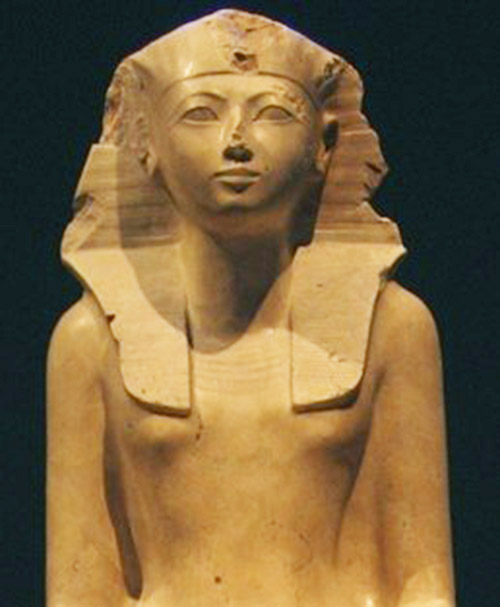

Hatshepsut, meaning Foremost of Noble Ladies, was the fifth pharaoh of the eighteenth dynasty of Ancient Egypt. She is generally regarded by Egyptologists as one of the most successful pharaohs, reigning longer than any other woman of an indigenous Egyptian dynasty.
Although contemporary records of her reign are documented in diverse ancient sources, Hatshepsut was described by early modern scholars as only having served as a co-regent from approximately 1479 to 1458 BC, during years seven to twenty-one of the reign previously identified as that of Thutmose III.
Today Egyptologists generally agree that Hatshepsut assumed the position of pharaoh and the length of her reign usually is given as twenty-two years, since she was assigned a reign of twenty-one years and nine months by the third-century BC historian, Manetho, who had access to many historical records that now are lost. Her death is known to have occurred in 1458 BC, which implies that she became pharaoh circa 1479 BC.
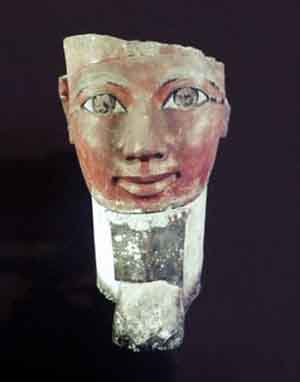
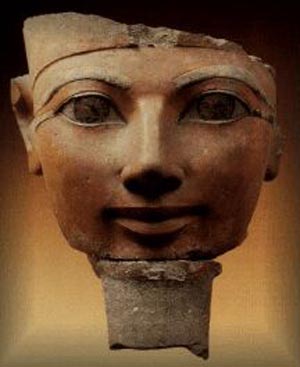
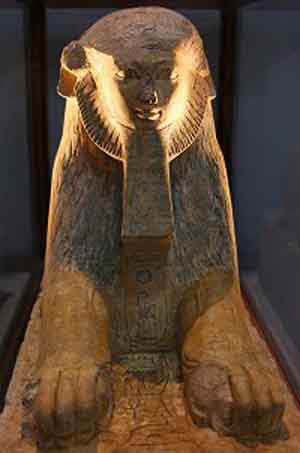
Although it was uncommon for Egypt to be ruled by a woman, the situation was not unprecedented. As a regent Hatshepsut was preceded by Merneith of the first dynasty, who was buried with the full honors of a pharaoh and may have ruled in her own right. Nimaethap of the third dynasty may have been the dowager of Khasekhemwy, but certainly acted as regent for her son, Djoser, and may have reigned as pharaoh in her own right. Nitocris may have been the last pharaoh of the sixth dynasty.
Her name is found in the Histories of Herodotus and writings of Manetho, but her historicity is uncertain. Queen Sobekneferu of the twelfth dynasty is known to have assumed formal power as ruler of "Upper and Lower Egypt" three centuries earlier than Hatshepsut. Ahhotep I, lauded as a warrior queen, may have been a regent between the reigns of two of her sons, Kamose and Ahmose I, at the end of the seventeenth dynasty and the beginning of Hatshepsut's own eighteenth dynasty.
Amenhotep I, also preceding Hatshepsut in the eighteenth dynasty, probably came to power while a young child and his mother, Ahmose-Nefertari, is thought to have been a regent for him. Other women whose possible reigns as pharaohs are under study include Akhenaten's possible female co-regent/successor (usually identified as either Nefertiti or Meritaten) and Twosret. Among the later, non-indigenous Egyptian dynasties, the most notable example of another woman who became pharaoh was Cleopatra VII, the last pharaoh of Ancient Egypt.
In comparison with other female pharaohs, Hatshepsut's reign was much longer and prosperous. She was successful in warfare early in her reign, but generally is considered to be a pharaoh who inaugurated a long peaceful era. She re-established trading relationships lost during a foreign occupation and brought great wealth to Egypt. That wealth enabled Hatshepsut to initiate building projects that raised the calibre of Ancient Egyptian architecture to a standard, comparable to classical architecture, that would not be rivaled by any other culture for a thousand years.
Hatshepsut was given a reign of about twenty-two years by ancient authors. Josephus writes that she reigned for twenty-one years and nine months, while Africanus states her reign lasted twenty-two years, both of whom were quoting Manetho. At this point in the histories, records of the reign of Hatshepsut end, since the first major foreign campaign of Tuthmosis III was dated to his twenty-second year, which also would have been Hatshepsut's twenty-second year as pharaoh.
Dating the beginning of her reign is more difficult, however. Her father's reign began in either 1506 or 1526 BC according to the low and high chronologies, respectively. The length of the reigns of Tuthmosis I and Tuthmosis II, however, cannot be determined with absolute certainty. With short reigns, Hatshepsut would have ascended the throne fourteen years after the coronation of Tuthmosis I, her father. Longer reigns would put her ascension twenty-five years after Tuthmosis I's coronation. Thus, Hatshepsut could have assumed power as early as 1512 BC, or, as late as 1479 BC.
The earliest attestation of Hatshepsut as pharaoh occurs in the tomb of Senenmut's parents where a collection of grave goods contained a single pottery jar or amphora from the tomb's chamber - which was stamped with the date Year 7. Another jar from the same tomb - which was discovered in situ by a 1935-1936 Metropolitan Museum of Art expedition on a hillside near Thebes - was stamped with the seal of the 'God's Wife Hatshepsut' while two jars bore the seal of 'The Good Goddess Maatkare. ' The dating of the amphorae, "sealed into the tomb's burial chamber by the debris from Senenmut's own tomb," is undisputed which means that Hatshepsut was acknowledged as the king of Egypt by Year 7 of her reign.
Hatshepsut established the trade networks that had been disrupted during the Hyksos occupation of Egypt during the Second Intermediate Period, thereby building the wealth of the eighteenth dynasty.
She oversaw the preparations and funding for a mission to the Land of Punt. The expedition set out in her name with five ships, each measuring 70 feet (21 m) long bearing several sails and accommodating 210 men that included sailors and 30 rowers. Many trade goods were bought in Punt, notably myrrh.
Most notably, however, the Egyptians returned from the voyage bearing thirty-one live myrrh trees, the roots of which were carefully kept in baskets for the duration of the voyage. This was the first recorded attempt to transplant foreign trees. It is reported that Hatshepsut had these trees planted in the courts of her Deir el Bahri mortuary temple complex. Egyptians also returned with living Puntites (people of Punt). This trading expedition to Punt was roughly during Hatshepsut's nineteenth year of reign.
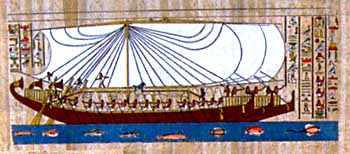
The Egyptians sent trading missions to Punt, a region of East Africa that was rich in gold, resins, ebony, blackwood, ivory and wild animals, including monkeys and baboons. They also went in search of slaves. The best-documented mission was sent during the reign of Hatshepsut. Scenes from these expeditions are illustrated on her funerary temple at Deir el-Bahari, near the Valley of the Kings.
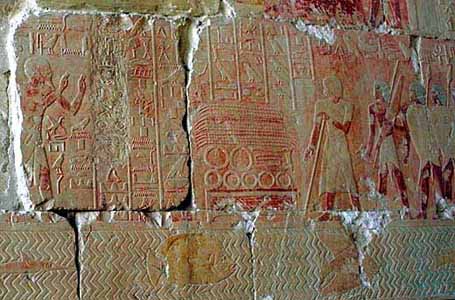
The expedition set out in her name with five ships, each measuring seventy feet (21 m) long, and with several sails; each ship accommodated 210 men, including sailors and thirty rowers. Many goods were bought in Punt, notably myrrh, which is said to have been Hatshepsut's favorite fragrance. Most notably however, the Egyptians returned from the voyage bearing thirty-one live frankincense trees, whose roots were carefully kept in baskets for the duration of the voyage. This was the first ever recorded attempt to replant foreign trees. She reportedly had the trees planted in the courts of her Deir el Bahari mortuary temple. She had the expedition commemorated in relief at Deir el-Bahri, which is famous for its unflattering depiction of the Queen of Punt.
Although many Egyptologists have claimed that her foreign policy was mainly peaceful, there is evidence that she led successful military campaigns in Nubia, the Levant and Syria early in her career.
Hatshepsut was an excellent propagandist, and while all ancient leaders used propaganda to legitimatize their rule, she is one of the most known for it. Much of her propaganda had religious overtones supported by the priests at the Temple of Karnak.
In ancient Egypt, women had a higher status than they did elsewhere in the ancient world, including the court-protected right to own or inherit property. Yet having a female ruler in her own right was rare: only Khent-Kaues, Sobeknefru and possibly Nitocris preceded her as ruling in their own name. Pharaoh was an exclusively male title; at this point in Egyptian history there was no word for a Queen regnant, only one for Queen consort. Hatshepsut is unique in that she was the first woman to take the title of King regnant or King in the absence of a word or title for Queen regnant.
She had the expedition commemorated in relief at Deir el-Bahri, which also is famous for its realistic depiction of the Queen of the Land of Punt, Queen Iti, who appears to have had a genetic trait called steatopygia. Hatshepsut also sent raiding expeditions to Byblos and Sinai shortly after the Punt expedition. Very little is known about these expeditions. Although many Egyptologists have claimed that her foreign policy was mainly peaceful, there is evidence that Hatshepsut led successful military campaigns in Nubia, the Levant, and Syria early in her career.
Hatshepsut was one of the most prolific builders in ancient Egypt, commissioning hundreds of construction projects throughout both Upper Egypt and Lower Egypt, that were grander and more numerous than those of any of her Middle Kingdom predecessors. Later pharaohs attempted to claim some of her projects as theirs.
She employed the great architect Ineni, who also had worked for her father, her husband, and for the royal steward Senemut. During her reign, so much statuary was produced that almost every major museum in the world has Hatshepsut statuary among their collections; for instance, the Hatshepsut Room in New York City's Metropolitan Museum of Art is dedicated solely to some of these pieces.
Following the tradition of most pharaohs, Hatshepsut had monuments constructed at the Temple of Karnak. She also restored the original Precinct of Mut, the ancient great goddess of Egypt, at Karnak that had been ravaged by the foreign rulers during the Hyksos occupation. It later was ravaged by other pharaohs, who took one part after another to use in their pet projects and awaits restoration. She had twin obelisks, at the time the tallest in the world, erected at the entrance to the temple. One still stands, as the tallest surviving ancient obelisk on Earth; the other has broken in two and toppled.
Another project, Karnak's Red Chapel, or Chapelle Rouge, was intended as a barque shrine and originally, may have stood between her two obelisks. It was lined with carved stones that depicted significant events in Hatshepsut's life.
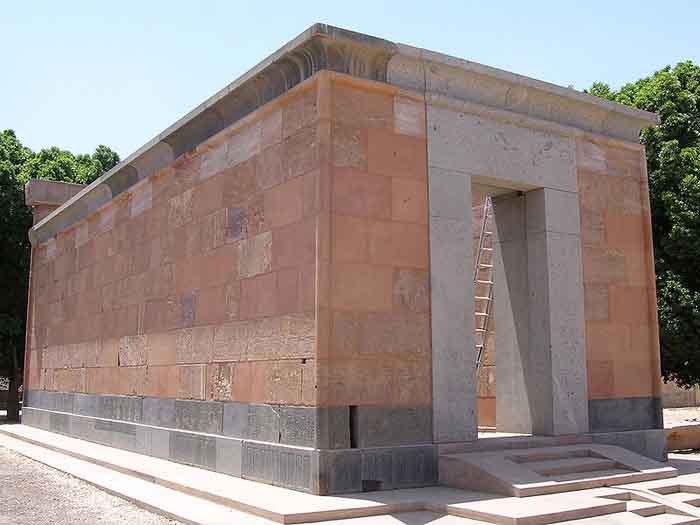
She later ordered the construction of two more obelisks to celebrate her sixteenth year as pharaoh; one of the obelisks broke during construction, and thus, a third was constructed to replace it. The broken obelisk was left at its quarrying site in Aswan, where it still remains. Known as The Unfinished Obelisk, it demonstrates how obelisks were quarried.
The Temple of Pakhet was built by Hatshepsut at Beni Hasan in the Minya Governorate south of Al Minya. The name, Pakhet was a synthesis that occurred by combining Bast and Sekhmet, who were similar lioness war goddesses, in an area that bordered the north and south division of their cults. The cavernous underground temple, cut into the rock cliffs on the eastern side of the Nile, was admired and called the Speos Artemidos by the Greeks during their occupation of Egypt, known as the Ptolemaic Dynasty.
They saw the goddess as a parallel to their hunter goddess Artemis. The temple is thought to have been built alongside much more ancient ones that have not survived. This temple has an architrave with a long dedicatory text bearing Hatshepsut's famous denunciation of the Hyksos that has been translated by James P. Allen. They had occupied Egypt and cast it into a cultural decline that persisted until a revival brought about by her policies and innovations. This temple was altered later and some of its inside decorations were usurped by Seti I, in the nineteenth dynasty, attempting to have his name replace that of Hatshepsut.
Following the tradition of many pharaohs, the masterpiece of Hatshepsut's building projects was her mortuary temple. She built hers in a complex at Deir el-Bahri. It was designed and implemented by Senemut at a site on the West Bank of the Nile River near the entrance to what now is called the Valley of the Kings because of all the pharaohs who later chose to associate their complexes with the grandeur of hers. Her buildings were the first grand ones planned for that location.
The focal point was the Djeser-Djeseru or "the Sublime of Sublimes", a colonnaded structure of perfect harmony nearly one thousand years before the Parthenon was built. Djeser-Djeseru sits atop a series of terraces that once were graced with lush gardens. Djeser-Djeseru is built into a cliff face that rises sharply above it. Djeser-Djeseru and the other buildings of Hatshepsut's Deir el-Bahri complex are considered to be significant advances in architecture. Another one of her great accomplishments is the Hatshepsut needle (also known as the granite obelisks).
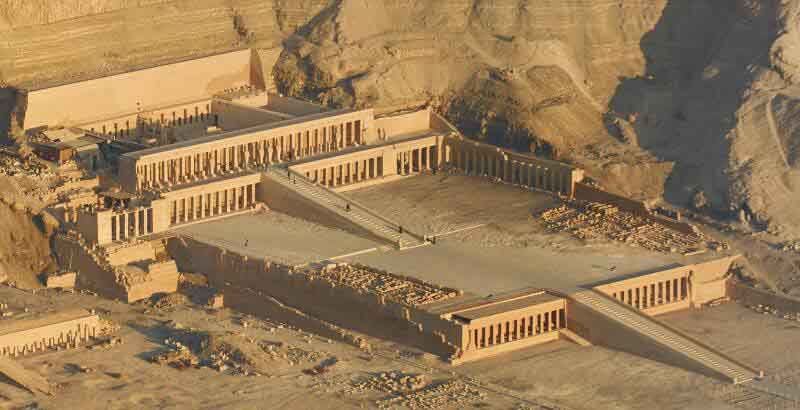
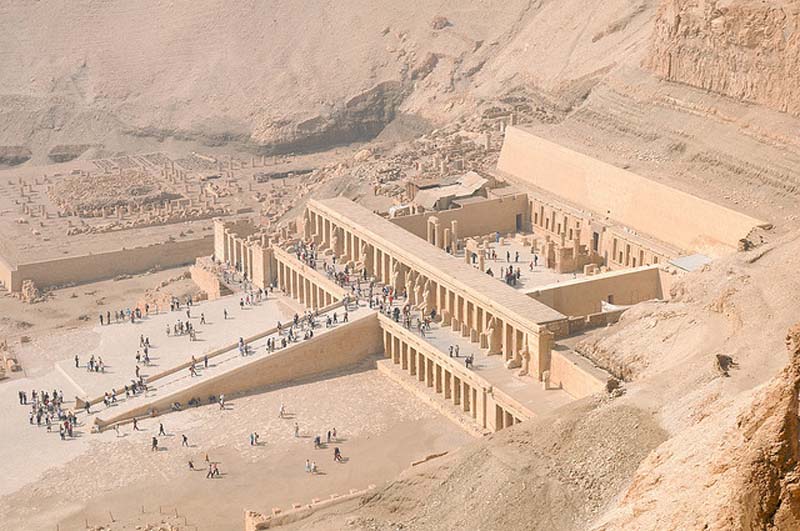
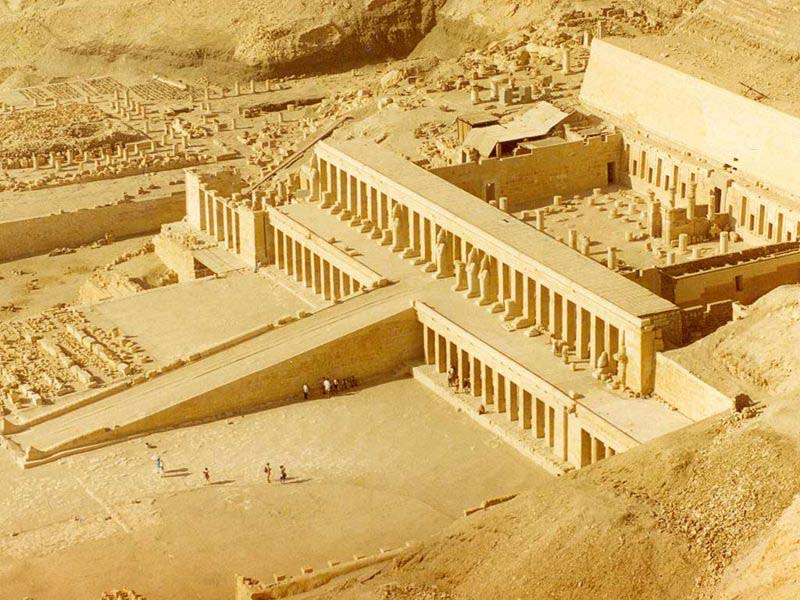
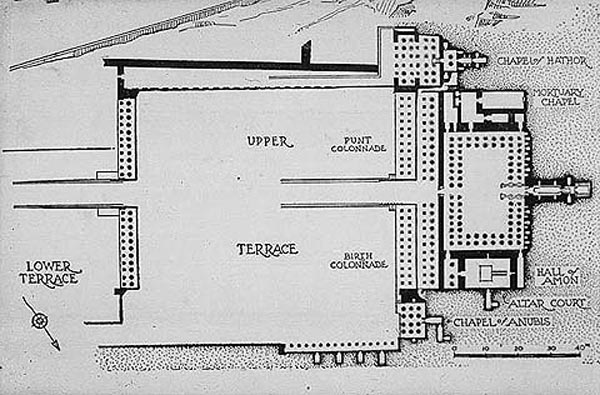
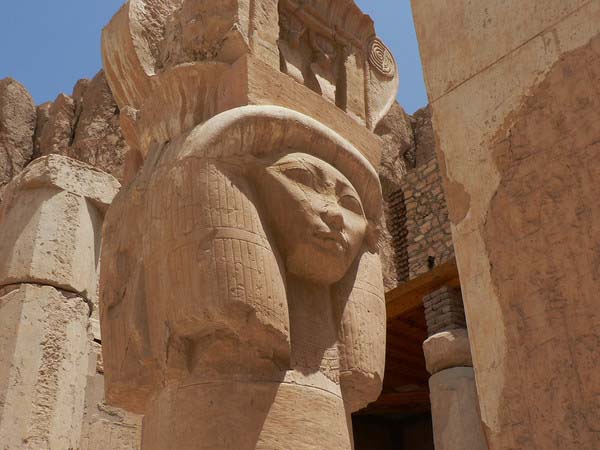
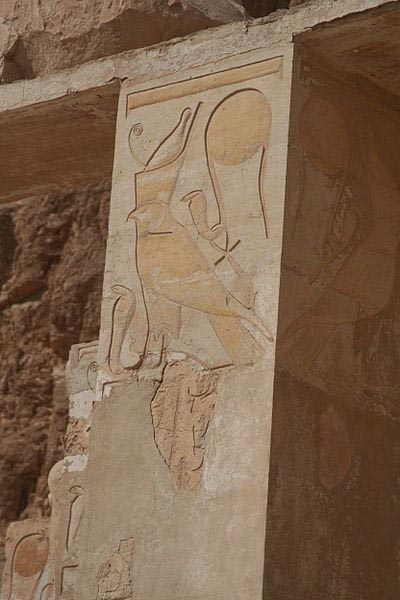
The Hawk of the Pharaoh, Hatshepsut - Temple at Luxor
Egypt revealed Saturday a rare trove of 30 ancient wooden coffins that have been well-preserved over millennia
in the archaeologically rich Valley of the Kings in Luxor PhysOrg - October 20, 2019
30 'Cachette of the Priests' Mummies Discovered in Egypt and Photos Live Science - October 20, 2019
Irene standing in front of the Temple of Queen Hatshepsut when we traveled to Egypt.
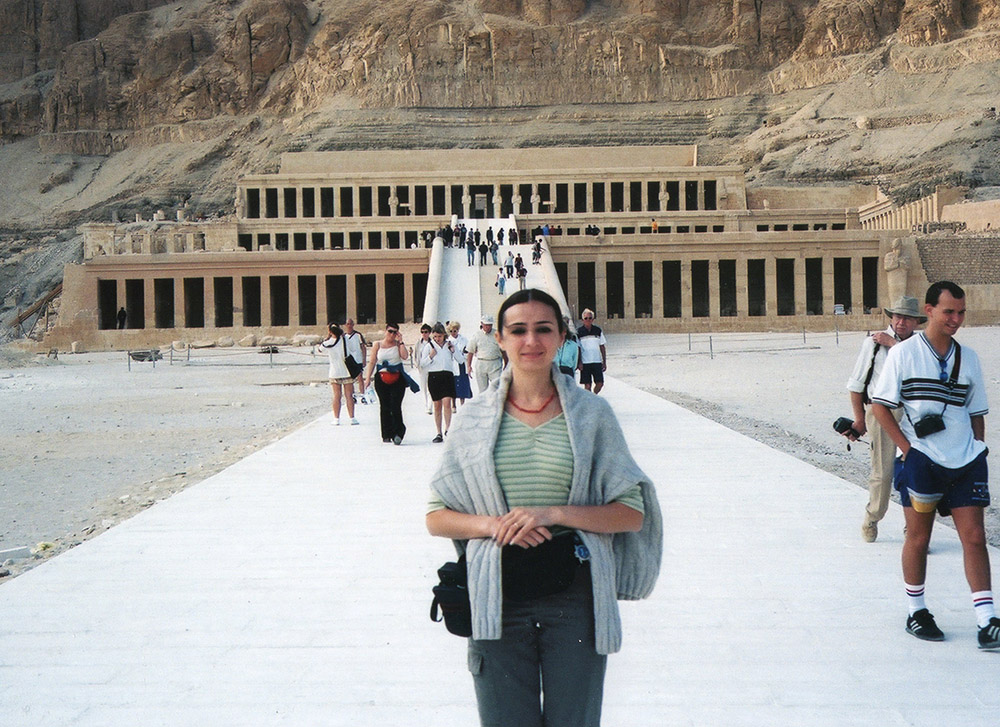
Hyperbole is common, virtually, to all royal inscriptions of Egyptian history. While all ancient leaders used it to laud their achievements, Hatshepsut has been called the most accomplished pharaoh at promoting her accomplishments. This may have resulted from the extensive building executed during her time as pharaoh, in comparison to many others. It afforded her with many opportunities to laud herself, but it also reflects the wealth that her policies and administration brought to Egypt, enabling her to finance such projects. Aggrandizement of their achievements was traditional when pharaohs built temples and their tombs.
Women had a high status in ancient Egypt and enjoyed the legal right to own, inherit, or will property. A woman becoming pharaoh was rare, however; only Sobekneferu, Neferneferuaten, and possibly Khentkaus I and Nitocris preceded her in known records as ruling solely in their own name.
The existence of this last ruler is disputed and is likely a mis-translation of a male king. Twosret, a female king and the last pharaoh of the nineteenth dynasty, may have been the only woman to succeed her among the indigenous rulers. In Egyptian history, there was no word for a "queen regnant" as in contemporary history, "king" being the Ancient Egyptian title regardless of gender, and by the time of her reign, pharaoh had become the name for the ruler.
Hatshepsut is not unique, however, in taking the title of king. Sobekneferu, ruling six dynasties prior to Hatshepsut, also did so when she ruled Egypt. Hatshepsut had been well trained in her duties as the daughter of the pharaoh. During her father's reign she held the powerful office of God's Wife. She had taken a strong role as queen to her husband and was well experienced in the administration of her kingdom by the time she became pharaoh. There is no indication of challenges to her leadership and, until her death, her co-regent remained in a secondary role, quite amicably heading her powerful army - which would have given him the power necessary to overthrow a usurper of his rightful place, if that had been the case.
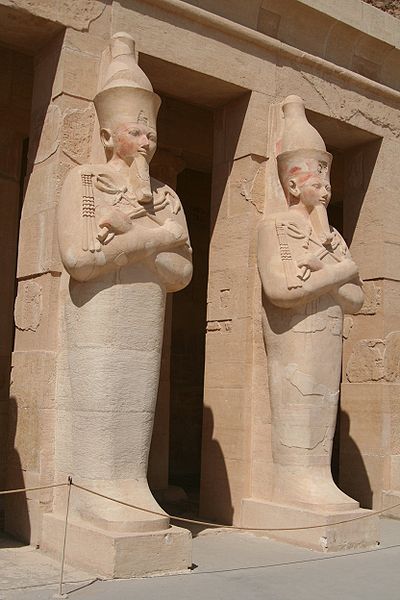
Osirian statues of Hatshepsut at her tomb, one stood at each pillar of the extensive structure, note the mummification shroud enclosing the lower body and legs as well as the crook and flail associated with Osiris - Deir el-Bahri
Hatshepsut assumed all of the regalia and symbols of the pharaonic office in official representations: the Khat head cloth, topped with the uraeus, the traditional false beard, and shendyt kilt. Many existing statues alternatively show her in typically feminine attire as well as those that depict her in the royal ceremonial attire. Statues portraying Sobekneferu also combine elements of traditional male and female iconography and, by tradition, may have served as inspiration for these works commissioned by Hatshepsut. After this period of transition ended, however, most formal depictions of Hatshepsut as pharaoh showed her in the royal attire, with all of the pharaonic regalia.
At her mortuary temple, in Osirian statues that regaled the transportation of the pharaoh to the world of the dead, the symbols of the pharaoh as the deity Osiris were the reason for the attire and they were much more important to be displayed traditionally, her breasts are obscured behind her crossed arms holding the regal staffs of the two kingdoms she ruled. This became a pointed concern among writers who sought reasons for the generic style of the shrouded statues and led to misinterpretations.
Understanding of the religious symbolism was required to interpret the statues correctly. Interpretations by these early scholars varied and often, were baseless conjectures of their own contemporary values. The possible reasons for her breasts not being emphasized in the most formal statues were debated among some early Egyptologists, who failed to understand the ritual religious symbolism, to take into account the fact that many women and goddesses portrayed in ancient Egyptian art often lack delineation of breasts, and that the physical aspect of the gender of pharaohs was never stressed in the art. With few exceptions, subjects were idealized.
Modern scholars, however, have theorized that by assuming the typical symbols of pharaonic power, Hatshepsut was asserting her claim to be the sovereign rather than a "King's Great Wife" or queen consort. The gender of pharaohs was never stressed in official depictions; even the men were depicted with the highly stylized false beard associated with their position in the society.
Moreover, the Osirian statues of Hatshepsut - as with other pharaohs - depict the dead pharaoh as Osiris, with the body and regalia of that deity. All of the statues of Hatshepsut at her tomb follow that tradition. The promise of resurrection after death was a tenet of the cult of Osiris. Since many statues of Hatshepsut depicted in this fashion have been put on display in museums and those images have been widely published, viewers who lack an understanding of the religious significance of these depictions have been misled. Aside from the face depicting Hatshepsut, these statues closely resemble those of other kings as Osiris, following religious traditions.
Most of the official statues commissioned of Hatshepsut show her less symbolically and more naturally, as a woman in typical dresses of the nobility of her day. Notably, even after assuming the formal regalia, Hatshepsut still described herself as a beautiful woman, often as the most beautiful of women, and although she assumed almost all of her father's titles, she declined to take the title "The Strong Bull" (the full title being, The Strong Bull of his Mother), which tied the pharaoh to the goddesses Isis, the throne, and Hathor, (the cow who gave birth to and protected the pharaohs) - by being her son sitting on her throne - an unnecessary title for her, since Hatshepsut became allied with the goddesses, herself, which no male pharaoh could. Rather than the strong bull, Hatshepsut, having served as a very successful warrior during the early portion of her reign as pharaoh, associated herself with the lioness image of Sekhmet, the major war deity in the Egyptian pantheon.
Religious concepts were tied into all of these symbols and titles. By the time of Hatshepsut's reign, the merger of some aspects of these two goddesses provided that they would both have given birth to, and were the protectors of, the pharaohs. They became interchangeable at times. Hatshepsut also traced her lineage to Mut, a primal mother goddess of the Egyptian pantheon, which gave her another ancestor who was a deity as well as her father and grandfathers, pharaohs who would have become deified upon death.
While Hatshepsut was depicted in official art wearing regalia of a pharaoh, such as the false beard that male pharaohs also wore, it is most unlikely that she ever wore such ceremonial decorations, just as it is unlikely that the male pharaohs did. Statues such as those at the Metropolitan Museum of Art, depicting her seated wearing a tight-fitting dress and the nemes crown, are thought to be a more accurate representation of how she would have presented herself at court.
As a notable exception, only one male pharaoh abandoned the rigid symbolic depiction that had become the style of the most official artwork representing the ruler, Pharaoh Amenhotep IV (later Akhenaten) of the same eighteenth dynasty, whose wife, Nefertiti, also may have ruled in her own right following the death of her husband.
One of the most famous examples of the legends about Hatshepsut is a myth about her birth. In this myth, Amun goes to Ahmose in the form of Thutmose I and awakens her with pleasant odors. At this point Amun places the ankh, a symbol of life, to Ahmose's nose, and Hatshepsut is conceived by Ahmose. Khnum, the god who forms the bodies of human children, is then instructed to create a body and ka, or corporal presence/life force, for Hatshepsut. Heket, the goddess of life and fertility, and Khnum then lead Ahmose along to a lioness' bed where she gives birth to Hatshepsut. Reliefs depicting each step in these events are at Karnak and in her mortuary temple.
Hatshepsut claimed that she was her father's intended heir and that he made her the heir apparent of Egypt. Almost all scholars today view this as historical revisionism, or prolepsis, on Hatshepsut's part since it was Thutmose II - a son of Thutmose I by Mutnofret - who was her father's heir. Moreover, Thutmose I could not have foreseen that his daughter Hatshepsut would outlive his son within his own lifetime. Thutmose II soon married Hatshepsut and the latter became both his senior royal wife and the most powerful woman at court. Biographer Evelyn Wells, however, accepts Hatshepsut's claim that she was her father's intended successor.
Hatshepsut disappeared in 1458 B.C. when Thutmose III, wishing to reclaim the throne, led a revolt. Thutmose had her shrines, statues and reliefs mutilated. Hatshepsut died as she was approaching what we would consider middle age given typical contemporary lifespans, in her twenty-second regnal year. The precise date of Hatshepsut's death - and the time when Thutmose III became the next pharaoh of Egypt - is considered to be Year 22, II Peret day 10 of her reign, as recorded on a single stela erected at Armant or January 16, 1458 BC.
This information validates the basic reliability of Mantheo King Lists records since Hatshepsut's known accession date was I Shemu day 4, (i.e.: Hatshepsut died 9 months into her 22nd year as king, as Manetho writes in his Epitome for a reign of 21 years and 9 months). No contemporary mention of the cause of her death has survived. If the recent identification of her mummy is correct, however, the medical evidence would indicate that she suffered from diabetes and died from bone cancer which had spread throughout her body while she was in her fifties It also would suggest that she had arthritis and bad teeth.
On June 26, 2007 it was announced that Egyptologists believe they have identified Hatshepsut's mummy in the Valley of the Kings. This discovery is considered to be the "most important find in the Valley of the Kings since the discovery of King Tutankhamun". Decisive evidence was a molar in a wooden box inscribed with Hatshepsut's name, found in 1881 in a cache of royal mummies hidden away for safekeeping in a near-by temple. The tooth was found to have been removed from the mummy's mouth beyond doubt.
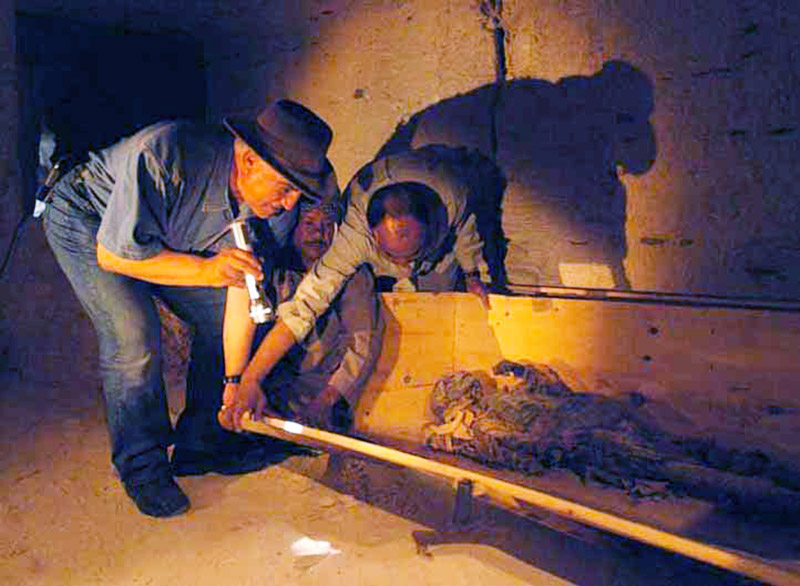
The Search for Hatshepsut and the Discovery of her Mummy
Egyptologists say they have identified the 3,000-year-old mummy of Hatshepsut

BBC - June 27, 2007
When she died Hatshepsut had begun construction of a tomb when she was the Great Royal Wife of Thutmose II, but the scale of this was not suitable for a pharaoh, so when she ascended the throne, preparation for another burial started. For this, KV20, originally quarried for her father, Thutmose I, and probably the first royal tomb in the Valley of the Kings, was extended with a new burial chamber. Hatshepsut also refurbished the burial of her father and prepared for a double interment of both Thutmose I and her within KV20. It is likely, therefore, that when she died (no later than the twenty-second year of her reign), she was interred in this tomb along with her father.
During the reign of Thutmose III, however, a new tomb, (KV38), together with new burial equipment was provided for Thutmose I, who then was removed from his original tomb and re-interred elsewhere. At the same time Hatshepsut's mummy might have been moved into the tomb of her wet nurse, Sitre-Re, in KV60. It is possible that Amenhotep II, son to Thutmose III by a secondary wife, was the one motivating these actions in an attempt to assure his own uncertain right to succession.
Besides what was recovered from KV20 during Howard Carter's clearance of the tomb in 1903, other funerary furniture belonging to Hatshepsut has been found elsewhere, including a lioness "throne" (bedstead is a better description), a senet game board with carved lioness-headed, red-jasper game pieces bearing her pharaonic title, a signet ring, and a partial shabti figurine bearing her name.
In the Royal Mummy Cache at DB320, an ivory canopic coffer was found that was inscribed with the name of Hatshepsut and contained a mummified liver or spleen as well as the tooth that now has been found to fit the second mummy in the wet nurse's tomb. There was a royal lady of the twenty-first dynasty of the same name, however, and for a while it was thought possible that it could have belonged to her instead.
Toward the end of the reign of Thutmose III and into the reign of his son, an attempt was made to remove Hatshepsut from certain historical and pharaonic records. This elimination was carried out in the most literal way possible. Her cartouches and images were chiseled off some stone walls, leaving very obvious Hatshepsut-shaped gaps in the artwork.
At the Deir el-Bahari temple, Hatshepsut's numerous statues were torn down and in many cases, smashed or disfigured before being buried in a pit. At Karnak, there even was an attempt to wall up her obelisks. While it is clear that much of this rewriting of Hatshepsut's history occurred only during the close of Thutmose III's reign, it is not clear why it happened, other than the typical pattern of self-promotion that existed among the pharaohs and their administrators, or perhaps saving money by not building new monuments for the burial of Thutmose III and instead, using the grand structures built by Hatshepsut.
Amenhotep II, the son of Thutmose III, who became a co-regent toward the end of his father's reign, is suspected by some as being the defacer during the end of the reign of a very old pharaoh. He would have had a motive because his position in the royal lineage was not so strong as to assure his elevation to pharaoh. He is documented, further, as having usurped many of Hatshepsut's accomplishments during his own reign. His reign is marked with attempts to break the royal lineage as well, not recording the names of his queens and eliminating the powerful titles and official roles of royal women such as, God's Wife of Amun.
For many years, presuming that it was Thutmose III acting out of resentment once he became pharaoh, early modern Egyptologists presumed that the erasures were similar to the Roman damnatio memoriae. This appeared to make sense when thinking that Thutmose might have been an unwilling co-regent for years. This assessment of the situation probably is too simplistic, however. It is highly unlikely that the determined and focused Thutmose -not only Egypt's most successful general, but an acclaimed athlete, author, historian, botanist, and architect -would have brooded for two decades of his own reign before attempting to avenge himself on his stepmother and aunt.
The erasures were sporadic and haphazard, with only the more visible and accessible images of Hatshepsut being removed; had it been more complete, we would not now have so many images of Hatshepsut. Thutmose III may have died before these changes were finished and it may be that he never intended a total obliteration of her memory. In fact, we have no evidence to support the assumption that Thutmose hated or resented Hatshepsut during her lifetime. Had that been true, as head of the army, in a position given to him by Hatshepsut (who was clearly not worried about her co-regent's loyalty), he surely could have led a successful coup, but he made no attempt to challenge her authority during her reign and, her accomplishments and images remained featured on all of the public buildings she built for twenty years after her death.
The erasure of Hatshepsut's name - whatever the reason or the person ordering it - almost caused her to disappear from Egypt's archaeological and written records. When nineteenth-century Egyptologists started to interpret the texts on the Deir el-Bahri temple walls (which were illustrated with two seemingly male kings) their translations made no sense. Jean-Francois Champollion, the French decoder of hieroglyphs, was not alone in feeling confused by the obvious conflict between words and pictures:
The 2006 discovery of a foundation deposit including nine golden cartouches bearing the names of both Hatshepsut and Thutmose III in Karnak may shed additional light on the eventual attempt by Thutmose III and his son Amenhotep II to erase Hatshepsut from the historical record and the correct nature of their relationships and her role as pharaoh.